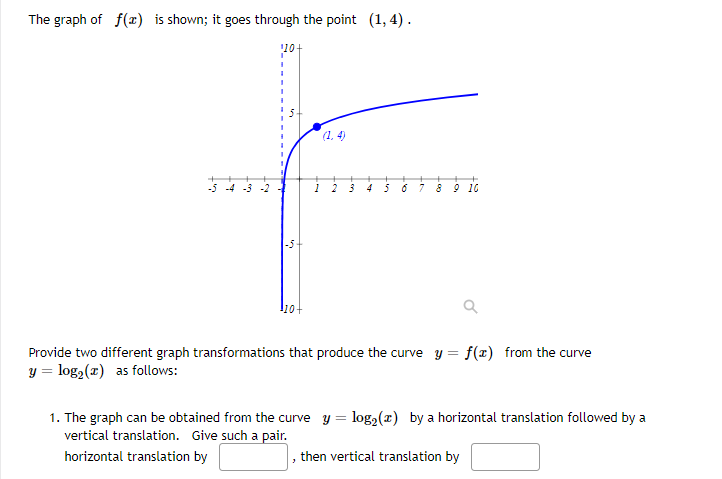The graph of f(a) is shown; it goes through the point (1, 4). (1. 4) -5 -4 -3 Provide two different graph transformations that produce the curve y = f(x) from the curve y = log2(x) as follows: 1. The graph can be obtained from the curve y = log2(x) by a horizontal translation followed by a vertical translation. Give such a pair. horizontal translation by then vertical translation by
The graph of f(a) is shown; it goes through the point (1, 4). (1. 4) -5 -4 -3 Provide two different graph transformations that produce the curve y = f(x) from the curve y = log2(x) as follows: 1. The graph can be obtained from the curve y = log2(x) by a horizontal translation followed by a vertical translation. Give such a pair. horizontal translation by then vertical translation by
Algebra & Trigonometry with Analytic Geometry
13th Edition
ISBN:9781133382119
Author:Swokowski
Publisher:Swokowski
Chapter4: Polynomial And Rational Functions
Section: Chapter Questions
Problem 5T
Related questions
Question

Transcribed Image Text:The graph of f(x) is shown; it goes through the point (1, 4) .
(1. 4)
-5 -4 -3
4
8 9 16
10-
Provide two different graph transformations that produce the curve y = f(x) from the curve
y = log2(x) as follows:
1. The graph can be obtained from the curve y = log2(x) by a horizontal translation followed by a
vertical translation. Give such a pair.
horizontal translation by
, then vertical translation by
Expert Solution
This question has been solved!
Explore an expertly crafted, step-by-step solution for a thorough understanding of key concepts.
This is a popular solution!
Trending now
This is a popular solution!
Step by step
Solved in 2 steps with 1 images

Knowledge Booster
Learn more about
Need a deep-dive on the concept behind this application? Look no further. Learn more about this topic, calculus and related others by exploring similar questions and additional content below.Recommended textbooks for you

Algebra & Trigonometry with Analytic Geometry
Algebra
ISBN:
9781133382119
Author:
Swokowski
Publisher:
Cengage

Algebra & Trigonometry with Analytic Geometry
Algebra
ISBN:
9781133382119
Author:
Swokowski
Publisher:
Cengage